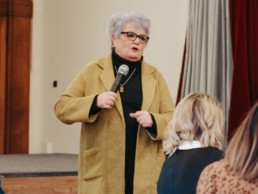Be the Speaker
The following blog is one of a series linked to the Talk:Write Programme to improve children’s oratory and writing. The series includes:
Be the Speaker: improve children’s confidence, clarity, correct use of English and skills of oratory as a speaker.
Be the Teacher: empower children to correct their own and other’s grammar and pronunciation in speech, or grammar, spelling and punctuation in writing.
Be Word Wise: enrich children’s vocabulary with a wide range of suave words that they know, understand, can spell and can use correctly in appropriate contexts.
Public speaking, also called oratory or oration, has traditionally meant the act of speaking face to face to a live audience. Today it includes any form of speaking (formally and informally) to an audience, including pre-recorded speech delivered over great distance by means of technology.
Confucius, one of many scholars associated with public speaking, once taught that if a speech was considered to be a good speech, it would impact the individuals’ lives whether they listened to it directly or not. His idea was that the words and actions of someone of power can influence the world.
Public speaking is used for many different purposes, but usually as some mixture of teaching, persuasion, or entertaining. Each of these calls upon slightly different approaches and techniques.
(Wikipedia)
Public speaking has rarely been taught in State Schools, and certainly not in primary schools, and is often perceived as being the jurisdiction of public schools and the ‘elite’. Talk:Write breaks this code and embraces public speaking, making it accessible to all so that every child may learn to speak clearly and confidently, with expression, with passion if appropriate and with deep sincerity.
In the individual disciplines for public speaking in the Wikipedia item quoted above, the definition for public speaking in the world of education is defined as:
The transfer of knowledge, which has many forms is not without public speaking. Here, it is not only the audience who learn from the speaker, but the speaker learns as well. Skills learnt can boost performance and productivity.
This philosophy is promoted through the half termly (or termly) speech where the pupil learns through the production, practise and improvement of their speech, and the class or school learn through listening to one another’s speeches.
We may have historically dismissed the need for public speaking in the schools where we teach, and yet we would all agree that the confident and articulate speaker has a far better chance of success in adulthood than the inarticulate or hesitant speaker may have. Furthermore, my work over the past 30 years has provided clear evidence that if ‘the child can’t say it, the child can’t write it’, but if the child CAN say it, the child can write it – providing they have both the basic skills and mechanical skills to write. Thus, the more we invest in improving speech, the greater the impact on a child’s writing.
The process for launching and maintaining this practice is easy, and children both enjoy and are enthusiastic about it. It can be implemented as a stand-alone strategy – the school need not be implementing the Talk:Write programme.
The following is the most commonly used approach:
Once a term, in the second half term (after children have had an opportunity to study and learn several aspects of subjects). It may be launched initially in Year 6, or across Key Stage 2 or across the whole school.
Year 6 Launch (Guidance Only)
Introduction
Children will need to witness speakers in oratory on things they care about. This may be done through video clips – for example of David Attenborough talking about our planet. The Headteacher or another member of staff could record the same speech twice, once in a form of local speak and the second time in full public speaking mode. The speech should be about something they care passionately about that is not related to the school.
Lesson 1:
- Children choose an aspect of their current studies (from any appropriate subject) that they are truly enjoying.
- They draft a paragraph about it, saying why they are enjoying it or finding it interesting.
- They identify two or three additional things they would really like to know about it.
- They may find additional detail or information through research.
- They may enrich their paragraph by adding suave features*.
- They practise reading it out loud (softly).
Lesson 2: (or part 2 of Lesson 1 if the lesson is longer than 50 minutes)
- Each child reads their piece out loud to their peers in small groups, in turn, concentrating on clarity and expression.
- They insert suave features* based on feedback from their group peers and adults and read them out loud again.
- Children read their own paragraphs several times and start to memorise.
Lesson 3: (or part 3 of Lesson 1 if a whole afternoon)
- Children take turns to stand at the front of the classroom and read or present from memory their pieces to the class or year.
- Teachers and peers use agreed criteria to check for: interest, sincerity, suave features*, clarity and confidence, expression and emotion, etc.** and provide feedback.
Homework:
Children take their paragraphs home and ‘perform’ them for family members by standing and reading or presenting from memory with expression and enthusiasm as appropriate.
They continue to practise reading aloud and memorising.
Final Lesson:
Children perform their paragraph for the class or year group.
There may be a mini vote for the ‘best’ three or four, based on the public speaking criteria. Teachers decide on three or four children to read out their speeches to the school in assembly, which will be recorded.
The chosen children should be given opportunity to practise delivering their speech in the school hall or the site for the assembly.
The Next Term:
Classes start preparing a new speech at the start of the second half of the next term and all classes in KS2 start doing public speaking.
All years in KS2 present their selected speakers in a final assembly at the end of the academic year.
History, science or geography are particularly good for this activity, but children should choose their own themes based upon their own personal interest, so the class overall may cover several subjects and many aspects of learning. For example, one child might be focussing on Tudor architecture, another on the incarceration of Ann Boleyn in the Tower of London and a third on the purpose and usage of ‘piss pots’, all under the umbrella studies of the Tudors. At the same time, one child could be writing about the lifestyle of a lumberjack, another about the impact of deforestation on climate and a third on its impact on wildlife in their studies of rainforests. Meanwhile, one child could be doing an explanatory paragraph about cloud formation and rainfall, based on their science studies, whilst another wrote a short report on the tracking of weather patterns over a month in their community.
The class teachers should explain why good speaking skills are important for later life, model code switching between two or more codes of speech and engage their classes in discussions about how they feel about ‘Be the Speaker’ and how they might improve their own performances. They might identify role models and style their own performances on their personal role model. Older children could work with younger children to coach them and encourage them.
Be the Speaker Contest:
Towards the end of each academic year, there could be a ‘Be the Speaker’ contest with selected speakers from each class / year performing for parents and the school and a trophy awarded to the ‘best’ or most improved.
The beauty of this is that – as the speaking improves and becomes more confident and fluent – so will the children’s writing within the wider range of their studies, as they transfer the qualities of voice and style learnt through their pursuit of the ability to be an effective speaker.
* Suave words, suave sentence openers, suave punctuation, suave connectives, rhetorical questions, detail and description.
** More examples are provided in the Talk:Write programme, which also includes advice and appropriate resources and activities.
Talk:Write
A fun and flexible approach to improving children’s vocabulary, speech, and writing.


